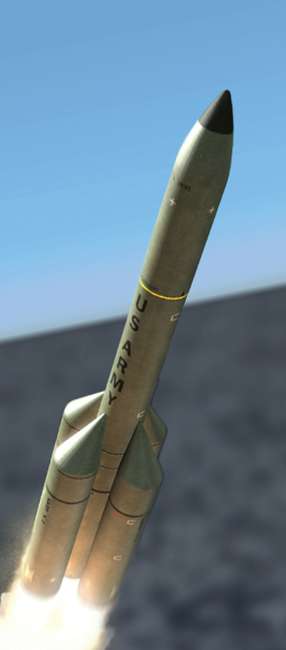U.S. Army Wants Nanomissiles to Launch Small Satellites

WASHINGTON? The U.S. Army's desire to deploy swarms of tiny satellites forvarioustactical missions is one of the reasons it began development two yearsago ofwhat would be the United States' smallest orbital launch vehicle,designed toput payloads of about 20 kilograms into space, government and industryofficials said.
TheArmy Space and Missile Defense Command (SMDC) in Huntsville, Ala.,conceivedthe Multipurpose Nanomissile system as a liquid-fueled core boosteraugmentedby various strap-on solid-rocket motors. [Army nanomissileconcept photo.]
Standingjust a little taller than a basketball hoop, the rocket's modularitycould makeit useful not only as a launch vehicle but potentially a missiledefensetarget, sounding rocket and hypersonic test vehicle as well, JohnLondon, SMDC'smanager for nanosatellitetechnology programs, said. It will also be a good way to makeuse of agingtactical solid-rocket motors that would otherwise be decommissioned,Londonsaid in a recent interview.
TheArmy had not built a satellite in nearly 50 years until recentlystarting ahandful of experimentalsatellite programs. Rather than building a small number ofvery expensivesatellites as the Air Force does, the Army is interested in large,cheapconstellations of spacecraft that can be easily replaced.
"Theinterest we have in the orbital part is that these nanosatelliteswe're building have price points that are between $300,000 and $1million persatellite," London said. "One of the reasons we like satellites ofthis class is we can afford to put a lot of them up there to where theentireconstellation is still relatively inexpensive. If one satellite upthere fails,and I need to replace it with a $300,000 satellite in a very specificorbit,and the lowest cost launch vehicle out there is at least 30 to 50 timesthecost of that spacecraft, that won't work."
Todevelop the Multipurpose Nanomissile System's core booster, the Army in2008contracted with Colsa Corp. and Dynetics Corp., both based inHuntsville. TheArmy has spend about $7 million to date on the Multipurpose NanomissileSystemand needs about $17 million more to complete development, London said.
Thebooster is almost 12 feet (3.6 meters) tall and nearly 24 inches (60cm) indiameter. Dynetics is mainly responsible for the booster's propulsionsystem,which uses a nitrous oxide-ethane blend to produce 3,000 pounds ofthrust,Steve Cook, Dynetics' director of space technologies, said in an Aug. 4interview. If completed, it will be the smallestlaunch vehicle available in the United States, he said.
Get the Space.com Newsletter
Breaking space news, the latest updates on rocket launches, skywatching events and more!
Theteam recently completed its sixth static fire test of the propulsionsystem,which lasted 60 seconds, about half of a full burn, Cook said. Thecompaniesare in negotiations with the Army to extend the companies' work andconduct afirst unguided suborbital booster flight test about in about a year, hesaid.
Inits most basic configurations, Multipurpose Nanomissiles could bepurchased foras little as $150,000 apiece if they are being produced in quantity,Londonsaid.
Ina launch vehicle configuration, the liquid core booster alone couldcarrypayloads of about 10 kilograms to low Earth orbit, and if fullyoutfitted withsolid-rocket motors for additional thrust, the payload capacity isaround 23kilograms, London said. The estimated production cost for the launchvehicleconfiguration is around $1 million, not including range and payloadintegrationcosts, he said.
TheArmy's approach to the Multipurpose Nanomissile program is unlike thatoftraditional government rocket programs, said Cook, a former NASAofficial wholed the development of the U.S. space agency's Ares family of rocketsbeforeresigning last summer.
Whereasmission assurance is the ultimate goal of other rockets, a low pricepoint isthe driving force for this program. That dictates not only that therocket bevery small in size, but also the use of inexpensive components such asstainless steel fuel tanks instead composite or aluminum ones, Cooksaid.
- MostDestructive Space Weapon Concepts
- TheTop 10Weapons in History
- ExperimentalU.S. Missile Defense Satellites Pass Big Tests
Thisstory was provided by Space News,dedicated tocovering all aspects of the space industry.
Join our Space Forums to keep talking space on the latest missions, night sky and more! And if you have a news tip, correction or comment, let us know at: community@space.com.
Turner Brinton is the director for public relations at Maxar Technologies, a space technology company based in Westminster, Colorado that develops satellites, spacecraft and space infrastructure. From 2007 to 2011, Turner served as a defense reporter for SpaceNews International, a trade publication dedicated to the global space industry. He left SpaceNews in 2011 to work in communications for Intelsat and later DigitalGlobe before joining the Maxar team.









